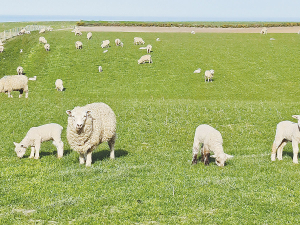How to prevent pneumonia in lambs at weaning
With weaning soon to get underway, some simple management strategies can help prevent the economic losses associated with pneumonia and pleurisy.
 Lambs born to ewes well fed during pregnancy have better lifetime reproductive performance than those from poorly fed mothers.
Lambs born to ewes well fed during pregnancy have better lifetime reproductive performance than those from poorly fed mothers.
Ewes' feeding requirements increase in the latter stages of pregnancy and even more so during lactation.
Multiple-bearing ewes need more feed as lambing approaches to prevent them losing condition.
Protein supply via a ewe’s milk is the crucial element in providing a good start for lamb growth. Ensuring good ewe nutrition to aid ewe milking is critical, particularly in late pregnancy and early lactation.
Lambs eat more grass as they age and twins, particularly, have to start eating pasture sooner than singles
Lambs born to wellfed ewes in late pregnancy have more energy stored as fat reserves and are better able to survive times of reduced feed – such as during windy, wet conditions or extreme weather. They also maintain their suckling drive longer than those whose mothers were poorly fed.
Ewe lambs born to ewes well fed during pregnancy have better lifetime reproductive performance than those from poorly fed mothers.
Excessive under nutrition before lambing can lead to:
All these can lead to reduced lamb survival and lower lamb weaning weights. Try to feed multiples at an appropriate feeding level above maintenance in the last five weeks of pregnancy in relation to number of lambs being carried.
It’s recommended rotations are kept going as long as possible, but reducing mob size and speeding up the rotations closer to lambing is an available option to reduce grazing pressure.
Lambing Date
Ideally lambing should begin at the same time as the annual increase in spring pasture production.
However, a high proportion of New Zealand farmers lamb too early for their feed supply to achieve high growth rates.
Aligning lambing dates with the spring flush almost invariably results in similar weaning weights and dates as lambing before the flush. Ewes also maintain better condition and, because pasture growth isn’t restricted by low leaf area (through over-grazing), pasture growth is optimised through late spring, summer and the rest of the year.
Contrary to popular opinion, earlier lambing does not necessarily produce heavier lamb weaning weights. It is better to lamb later and achieve faster growth rates, than lamb early at the expense of optimal lamb growth. Generally later lambing enhances both lamb growth and ewe condition when pastures can be controlled by cattle grazing or mechanical topping.
Source: B+LNZ
New Zealand’s national lamb crop for the 2025–26 season is estimated at 19.66 million head, a lift of one percent (or 188,000 more lambs) on last season, according to Beef + Lamb New Zealand’s (B+LNZ) latest Lamb Crop report.
OPINION: Just what falls out of the coalition’s plan to reform local government and environment law is anyone’s guess.
Farmers appear to be cautiously welcoming the Government’s plan to reform local government, according to Ag First chief executive, James Allen.
The Fonterra divestment capital return should provide “a tailwind to GDP growth” next year, according to a new ANZ NZ report, but it’s not “manna from heaven” for the economy.
Fonterra's Eltham site in Taranaki is stepping up its global impact with an upgrade to its processed cheese production lines, boosting capacity to meet growing international demand.
Canterbury farmer Michelle Pye has been elected to Fonterra’s board for a three-year term.

OPINION: Your old mate welcomes the proposed changes to local government but notes it drew responses that ranged from the reasonable…
OPINION: A press release from the oxygen thieves running the hot air symposium on climate change, known as COP30, grabbed your…